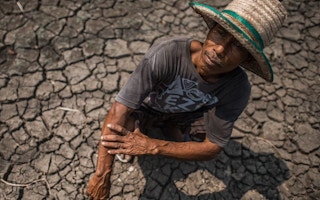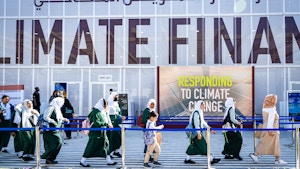Underinvestment in climate adaptation in Asia Pacific could lead to growing populism, societal polarisation, social unrest and conflict, the United Nations Development Programme (UNDP) has warned.
Speaking at the launch of a new report, Making our Future: New Directions for Human Development in Asia and the Pacific, Philip Schellekens, UNDP’s chief economist, said that climate shocks could lead to rising inequality and “fan the flames of polarisation” in countries across the region.
Deteriorating social cohesion as the planet warms could in turn limit the political space for climate action. The report noted that Southeast Asia is experiencing an erosion of democracy and limiting of public and civic spaces to a degree last seen in the late 1970s, which threatens the region’s capacity to tackle climate change.
While 30 countries in Asia Pacific have pledged to reduce emissions, most lack well-financed strategies to put this into effect, and governments have given greater priority to economic growth and poverty reduction, the report noted.
Climate adaptation refers to measures taken to defend food, water and infrastructure systems against the effects of climate change, such as drought-resistant crops, mangrove restoration, coastal barrier protection and improved access to safe water.
“
There is no doubt about the risk of underinvesting in climate adaptation leading to regional conflict.
Yusuke Taishi, senior technical advisor, climate change adaptation, United Nations Development Programme
Climate change is projected to depress growth in global agriculture yields by up to 30 per cent by 2050 and increase the number of people without access to sufficient water from 3.6 billion today to more than 5 billion by 2050, according to Global Commission on Adaptation (GCA).
“There is no doubt about the risk of underinvesting in climate adaptation leading to regional conflict,” Yusuke Taishi, senior technical advisor, climate change adaptation, UNDP, told Eco-Business. He pointed to conflict in South Sudan over water resources as an example of how climate change is affecting vulnerable developing countries.
Climate adaptation measures tend to be underfunded. A November 2022 study by emerging markets-focused bank Standard Chartered found that only 0.19 per cent of available capital in Asia is going into the adaptation economy. By comparison, billions are being channelled into climate mitigation measures such as installing wind farms and solar fields.
According to UNDP’s study, 27 countries in the Asia Pacific region have updated their climate adaptation plans, but only 8 per cent of available regional climate finance has been set aside for adaptation.
Investing in climate adaptation can produce economic benefits. According to GCA, investing US$1.8 trillion globally in early warning systems, climate-resilient infrastructure, improved dryland agriculture, mangrove protection, and resilient water resources by 2030 could generate US$7.1 trillion in net benefits.
Climate adaptation finance is expected to be high on the agenda at the COP28 climate talks at the end of the month. Negotiations will focus on a loss and damage fund to help vulnerable countries adapt to climate change. The world’s biggest historical polluter, the United States, is controversially pushing for the fund to be voluntary.
A recent study by the Organisation for Economic Co-operation and Development found that wealthy countries are still falling short of a 14-year old commitment to help developing countries adapt to a changing climate with US$100 billion in annual funding.
In 2021, climate finance provided by the Global North reached US$89.6 billion, an increase of 8 per cent year on year – but still US$10 billion short of the pledged amount.
Taishi said that while it is hard to predict the outcome of the COP28 climate talks that start at the end of November, it is widely expected that climate adaptation pledges “will not come anywhere near what is needed”.
However, he said there have been positive moves from the private sector to help fill the finance gap, “partially fuelled by the frustration that state-led negotiations [around adaptation finance] are not going anywhere.”
UNDP’s partnership with the World Health Organisation and private sector donors to deliver clean electricity to health facilities that lack energy access is one example of how the private finance can be funnelled into the adaptation economy, he said.
“Partnerships with the private sector are key,” UNDP’s report noted. “Climate risk financing and transfer, for example, is gaining traction in Asia, however, only a third of the estimated economic losses due to climate were insured.”
Scaling up risk transfer can reduce and manage climate risks, particularly to agriculture and infrastructure, it noted.
By linking initiatives to start-up ecosystems, governments and partners could leverage technological solutions for adaptation, according to the report. The role of governments remains critical in supporting an enabling environment for private financing to accelerate the re-direction of funds.
“What we have available now is nowhere near what is needed. So we need to see more of these partnerships [to fill the climate adaptation finance gap],” Taishi said.





















